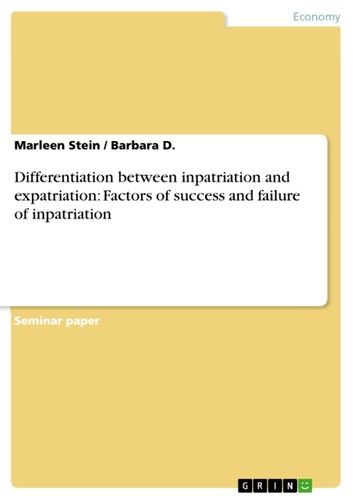| FindBook |
有 1 項符合
Differentiation between inpatriation and expatriation: Factors of success and failure of inpatriation的圖書 |
 |
Differentiation between inpatriation and expatriation: Factors of success and failure of inpatriation 作者:Marleen Stein,Barbara D. 出版社:GRIN Publishing 出版日期:2011-06-10 語言:英文 |
| 圖書館借閱 |
| 國家圖書館 | 全國圖書書目資訊網 | 國立公共資訊圖書館 | 電子書服務平台 | MetaCat 跨館整合查詢 |
| 臺北市立圖書館 | 新北市立圖書館 | 基隆市公共圖書館 | 桃園市立圖書館 | 新竹縣公共圖書館 |
| 苗栗縣立圖書館 | 臺中市立圖書館 | 彰化縣公共圖書館 | 南投縣文化局 | 雲林縣公共圖書館 |
| 嘉義縣圖書館 | 臺南市立圖書館 | 高雄市立圖書館 | 屏東縣公共圖書館 | 宜蘭縣公共圖書館 |
| 花蓮縣文化局 | 臺東縣文化處 |
|
|
圖書介紹 - 資料來源:樂天KOBO 評分:
圖書名稱:Differentiation between inpatriation and expatriation: Factors of success and failure of inpatriation
Seminar paper from the year 2011 in the subject Business economics - Personnel and Organisation, grade: 1,5, European School of Business Reutlingen, language: English, abstract: Introduction In the globalized world the competition gets aggravated and multinational companies (MNCs) seek out for new practices to stay competitive. One solution is cognitive and cultural diversity, implemented by multicultural management teams. Nevertheless a prerequisite is that international human resource management (IHRM) and the strategic goals of the organization will be linked (Harvey, Speier, Novicevic 1999b). This is necessary for the development of a distinctive competency, which constitutes a competitive advantage through diversity. Diversity prevents groupthink and facilitates a repertoire of different strategic choices, which is crucial to stay competitive. To approach this goal, MNCs avail themselves of international assignments, meaning to require an employee (manager) to work abroad for a specific purpose. The different purposes of international assignments will be examined in chapter 2.3. There are two typical forms of international assignments: expatriation and inpatriation. This paper examines the inpatriation process, concerning: - the different assignee types - the differentiation between inpatriation and expatriation - the purpose of international assignments, especially inpatriation - the advantages of inpatriation compared to expatriation and vice versa - motives, expectations and challenges of inpatriation from different points of view - preparation by the inpatriate - cultural challenges (culture shock) and coping tips - preparation, assistance/support and training for the inpatriate and factors which have to be considered This paper will conclude what factors make the inpatriation successful, and what can lead to failure. [...]
|











